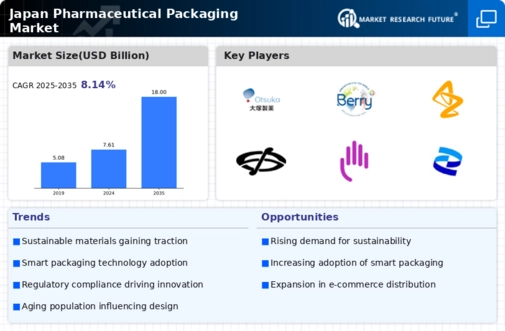Focus on Environmental Regulations
Japan's stringent environmental regulations are influencing the pharmaceutical packaging market, as companies are compelled to adopt sustainable practices. The government has set ambitious targets for reducing plastic waste, which is prompting manufacturers to explore biodegradable and recyclable materials. This shift is not only a response to regulatory pressures but also aligns with consumer preferences for environmentally friendly products. As a result, the pharmaceutical packaging market is likely to witness a transformation in material selection and design, with an emphasis on sustainability. Companies that proactively adapt to these regulations may gain a competitive edge in the market, appealing to environmentally conscious consumers.
Rising Demand for Biopharmaceuticals
The increasing prevalence of chronic diseases in Japan is driving the demand for biopharmaceuticals, which require specialized packaging solutions. The pharmaceutical packaging market is adapting to accommodate these products, which often necessitate advanced materials and designs to ensure stability and efficacy. As biopharmaceuticals are projected to account for over 30% of the total pharmaceutical market by 2025, the need for innovative packaging that can maintain the integrity of these sensitive products is paramount. This trend is likely to propel growth in the pharmaceutical packaging market, as manufacturers seek to develop packaging that meets the unique requirements of biopharmaceuticals, including temperature control and protection from light.
Growth of E-commerce in Pharmaceuticals
The rise of e-commerce in Japan is reshaping the pharmaceutical packaging market, as online sales of medications and health products continue to expand. With an estimated growth rate of 15% annually in the e-pharmacy sector, packaging must evolve to ensure safe and secure delivery of products. This includes the development of tamper-evident and moisture-resistant packaging solutions that can withstand the rigors of shipping. As consumers increasingly turn to online platforms for their pharmaceutical needs, the market is likely to see a surge in demand for packaging that not only protects the product but also enhances the unboxing experience, thereby influencing purchasing decisions.
Consumer Preference for User-Friendly Packaging
In Japan, there is a noticeable shift towards user-friendly packaging solutions, particularly among the aging population. The pharmaceutical packaging market is responding to this demographic change by designing packaging that is easier to open and handle. This includes features such as child-resistant closures and clear labeling, which enhance usability for elderly patients. As the population aged 65 and over is expected to reach 30% by 2030, the demand for accessible packaging is likely to increase. This trend not only improves patient compliance but also drives innovation within the pharmaceutical packaging market, as companies strive to create solutions that cater to the specific needs of this demographic.
Technological Integration in Packaging Solutions
Advanced technologies are increasingly being integrated into packaging solutions in the pharmaceutical packaging market. Innovations such as smart packaging, which includes QR codes and NFC technology, are enhancing traceability and consumer engagement. These technologies allow for real-time monitoring of product conditions, ensuring that medications are stored and transported under optimal conditions. As the demand for transparency and safety in pharmaceuticals grows, the adoption of such technologies is likely to accelerate. This trend not only improves supply chain efficiency but also fosters trust among consumers, thereby driving growth in the pharmaceutical packaging market.





















Leave a Comment